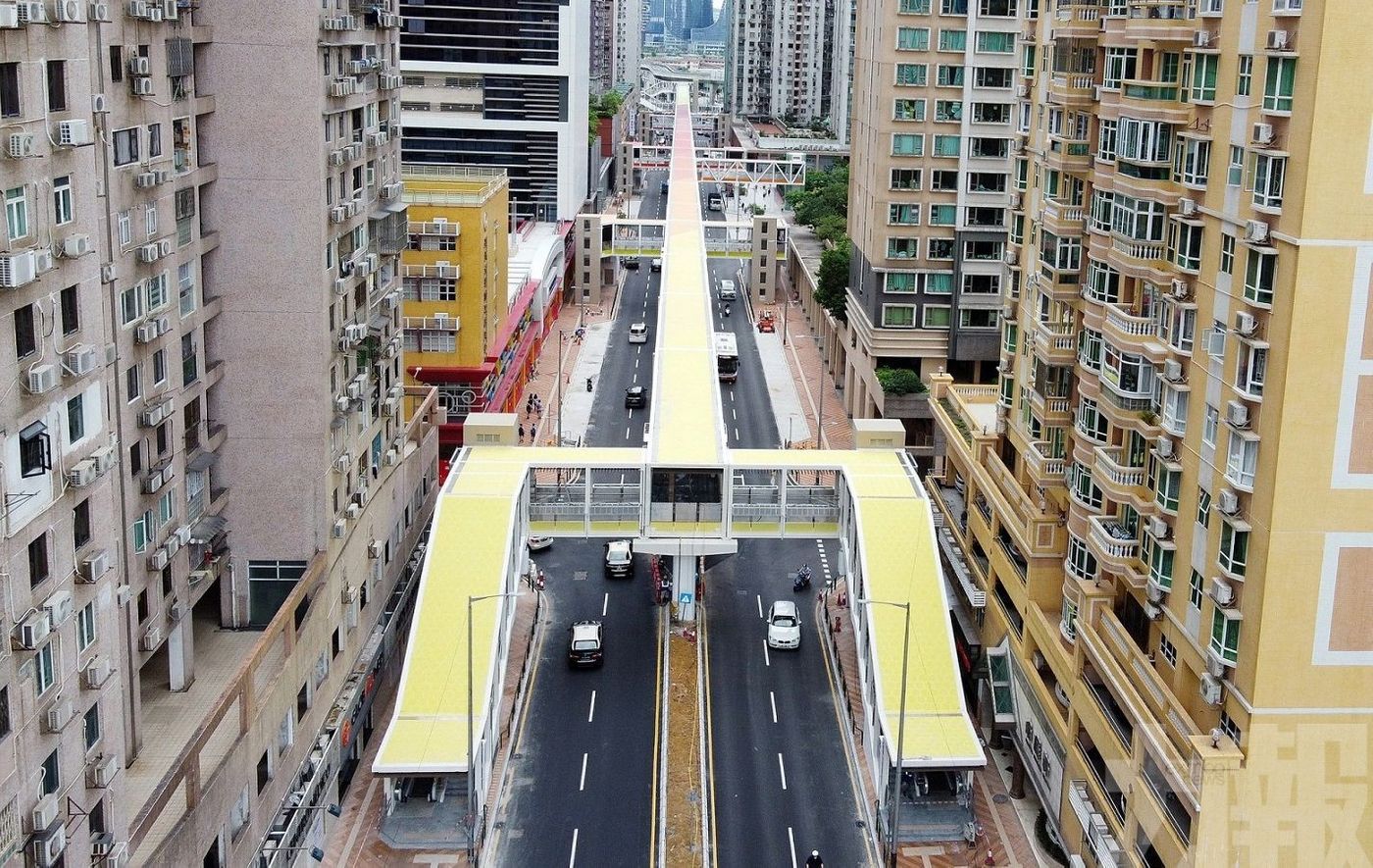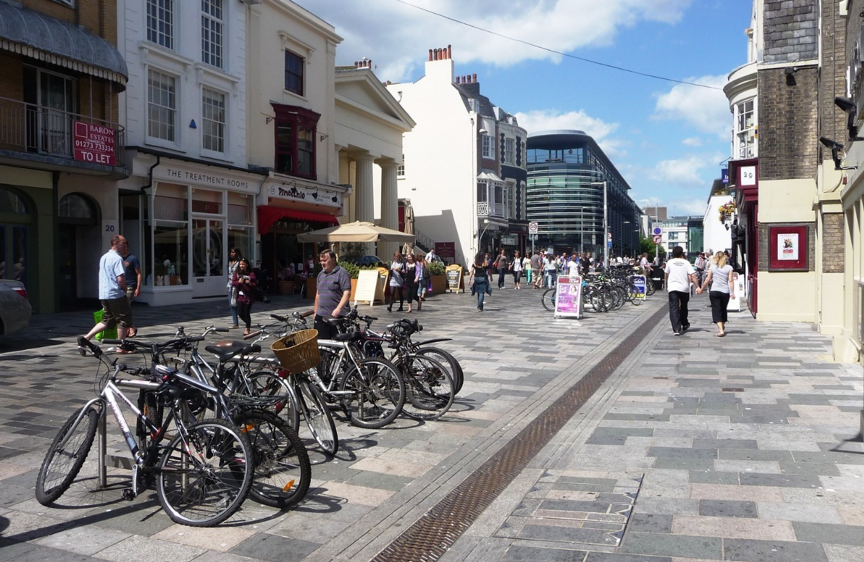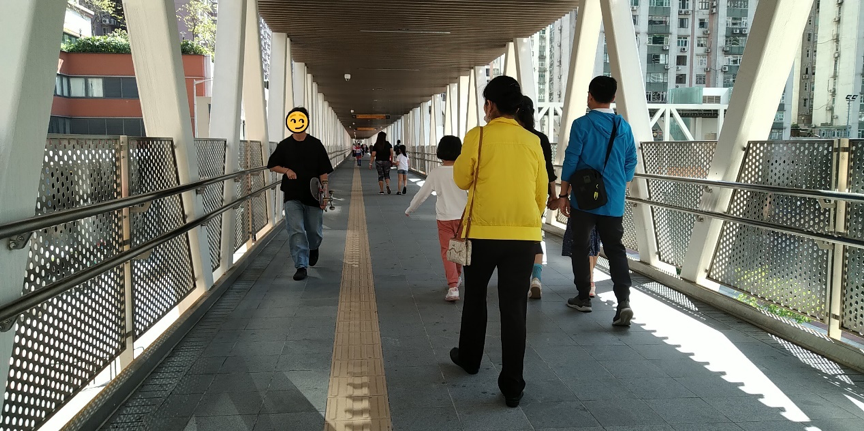Thoughts on the lack of transportation planning in Macau: some inspiration from the air corridor of Avenida Guimaras|Contribution #04
Author: Victor9104 (a passerby who finally found a full-time job after returning to Australia for more than half a year after completing his master's degree during the epidemic)
Myths about Macau’s transportation planning
In Macau, when the word "traffic planning" is generally thought of, it is natural to think only of vehicles. Just as the Public Works Bureau recently ignored public doubts and planned to relocate ten ancient trees in Zhuojia Village to open up Guimaras Avenue, just for the sake of vehicles. Convenient to travel. In addition to road opening and lane widening, transportation planning issues such as parking space supply and public transportation services are actually focused on "cars".
But "people" themselves are also part of the transportation system, so transportation planning should not only manage vehicles. It is also important to straighten out the relationship between people and vehicles. In the final analysis, as a person living in a city, transportation facilities, whether for vehicles or pedestrians, are used by "people".
Since Avenida de Quimaras is mentioned, let’s talk in depth about the Avenida de Quimaras Sky Corridor (hereinafter referred to as the Aerial Corridor), which faced heavy traffic during the construction process and a very long construction period. It may also be expanded in the future. During the several-year construction process, its effectiveness has been questioned, the design has been changed again and again, and construction has caused a lot of noise and air pollution.

What are the concepts behind this air corridor, which has been criticized and even considered a waste of public funds, its actual usage, and even its implications for the construction of related pedestrian facilities in the future?
The deeper meaning of the (layered) separation between people and vehicles
Danish architect Jan Gehl mentioned that from the 1950s to the 1970s [Note 1], in order to develop traffic, road engineering mainly considered how to prevent pedestrian accidents and increase the capacity of the driving roads, so pedestrian tunnels or pedestrian overpasses were set up to solve this problem. problem, but it later emerged that pedestrians only use it when they have no other choice.
The so-called "no choice" means that there are obstacles on both sides of the road that prevent pedestrians from crossing the road, or there is a lot of traffic and fast speeds. In this case, pedestrian bridges become the last solution to ensure that pedestrians can cross safely without blocking the traffic flow.
As a result, if pedestrians want to cross the road legally and safely to the other side, they have to go up and down (increase the distance) to meet the demand. In this way, pedestrians and vehicles are in two different traffic parallel time and spaces, and a large number of pedestrians are completely isolated from urban activities, making the streets boring. [Note 2] These relate to the activity density of the street itself. When the activity density is high, the street can provide pedestrians with a changing experience. [Note 3]

Stephen Graham [Note 4] also mentioned the "three-dimensional city" developed in Britain after post-war reconstruction, which separates people and vehicles. Vehicles (the passage) are released from the intervention of passers-by, making people feel that the presence of pedestrians itself is hindering the smooth passage of vehicles. Graham also mentioned that critics of this urban structure also doubt the effectiveness of elevated pedestrian corridors in the UK. Construction, in fact, just wants to remove people (from the streets) from the proliferation of vehicles, as seen in the example of corridor cities in the United States:
"The street level can easily become a 'remnant' - barren and commercially dead."
In short, transportation construction such as air corridors is only a product of meeting vehicle demand. As Gehl [Note 5] mentioned that building more roads in order to relieve traffic congestion will actually produce more traffic and traffic jams.
In the author's master's thesis [Note 6], some interviewees pointed out that it is not a humane thing to continue to build pedestrian bridges just by saying "separate pedestrians and vehicles", and when foreign countries advocate not to build pedestrian bridges frequently, Macau is doing the opposite.
The interviewee also believed that although the original intention of setting up the sky corridor included reasons such as pedestrians obeying the rules and ensuring pedestrian safety, the underlying idea was still to ensure smooth traffic flow.
Because there are actually other main roads near Guimaras Avenue that can share traffic, or traffic lights can be installed to enhance pedestrian safety. However, the government chose to spend huge sums of money to build air corridors, which instead became to accommodate the smooth flow of vehicles. Pedestrians have to sacrifice more time to use the sky corridor (which only adds to the inconvenience), and there is nothing to please pedestrians on the way.
Respondents questioned whether such separation of people and vehicles was necessary, and believed that the government had not actually considered how to deal with the problem of too many vehicles. However, the so-called "smooth traffic flow" may not necessarily be true. Interviewees pointed out that the entrance and exit of the sky corridor at the intersection and the bridge pillars dividing the island can easily create blind spots for vehicles, which means that drivers need to drive slowly and observe the road conditions.
What actually happens in and around the Skywalk
Nearly a year after the air corridor was opened for use, the number of users is not small, but it is "forced" to a certain extent - in order to encourage more people to use the air corridor, the government made Guimaras larger when it was opened. All zebra crossings on the road will be deleted, and only zebra crossings on the transverse roads will remain at each intersection.
After some pedestrians walk onto the sky corridor, in order to avoid having to cross the zebra crossing again when they land, they will walk directly on the sky corridor for a while before leaving at the entrance and exit near the destination (at least this author can).
The author even accidentally saw people exercising on the sky corridor when using it at night. This is also a kind of function that breaks away from the preset use. Just like the New Port Reservoir Recreation Area, different residents use it for daily commuting. It can also be used for exercise.
Given the small area of Macao and the lack of urban open space, such a functional performance seems reasonable, and can it be regarded as "making the best use of everything"?

As for whether the sky corridor makes driving smoother, it actually does not; although it does make driving a little faster without having to yield to pedestrians frequently, it is only a little bit.
For example, the author has been working part-time as a food delivery worker in Taipa District in recent months, and has cycled through Guimaras Avenue N times at least five days a week. He often drives slowly because his sight around turns is easily obstructed (exactly what the interviewee mentioned above) to that). Motorcycles are fine, but private cars often need to drive a little further to take a closer look. After all, the fishglasses installed at intersections may not necessarily be able to see clearly, which can lead to blocking the road.
For drivers like me, the so-called smoother traffic flow actually means little. Maybe it's faster in terms of data, but sometimes the feeling is not much different from the normal zebra crossing for pedestrians. Furthermore, the total length of Guimaras Main Road is only about 500 meters, and there are four intersections not counting the roundabouts at both ends. Moreover, there are often vehicles entering and exiting each of the very short intersections, so in fact it is not much faster.
"Separation of people and vehicles" in sky corridors: unnecessary
In the conclusion of the paper, the author mentioned that the sky corridor lacks good interaction with the horizontal street function where it is located [Note 7]. In fact, this is a "result". The cause of this phenomenon is also related to the number of activity opportunities provided by the road itself.
Assume that there are originally many shops on the main road of Quimaras, and the buildings are all podium shopping malls with reserved space to connect to the sky corridor. Under this situation, the author believes that air corridors can play more roles, even though the disadvantages of "separating people and vehicles" are relatively obvious.
In addition to connecting to the light rail station at the southern end, the actual sky corridor only has entrances and exits connecting various intersections and the Central Park parking lot. There are actually not many shops on the road. After its opening, apart from the shift in pedestrian activity demands (movement, crossing), it generally did not have a significant impact on the changes in pavement activity on both sides of Guimaras Avenue.

If we compare the above assumptions and reality from the perspective of "separation of people and vehicles", we will find that the former is more like the three-dimensional city or "isolated urban activities" discussed by other scholars; the latter is the government's attempt to radiate light rail The effect is amplified while ensuring pedestrian safety and smooth traffic flow, but it does not consider the need to connect the streets and is a bit "superfluous" in terms of the existing spatial configuration. From the perspective of street activities, it does not make pedestrians more pleasant, and driving is not necessarily smoother.
In the end, although it has certain practicality, it feels like "the wrong thing was built in the wrong place", an embarrassing situation that is unpalatable to both sides. [Note 8]
Things to think about in future related construction
To be honest, I am not very optimistic about the future development of Macau’s pedestrian system.
Although there are actually some pedestrian systems that meet the needs of the public, such as the Songshan Cheukong Pavilion lift system, the Songshan pedestrian tunnel, and the escalator in Xinxie Lane, etc., after all, the Macau government basically operates with an "engineer's mindset" and very few (and seemingly Discourage) Consider the pros and cons of building certain transportation facilities from a practical humanistic perspective.
The Sky Corridor and the other examples mentioned above just "just" play some role, but it does not necessarily mean that other areas in Macau must "cook the bowl" and provide similar facilities, just like the proposed Seac Pai Van community leading to Coloane High There are still many people who hold different opinions, such as the elevator system on the roof and the air corridor plan for the Northeast Avenue of the Macau Peninsula.
On the other hand, many Macau people have been "trained" to have a mentality that when they learn about certain proposed projects, they will only think of the huge expenditure of public funds, transfer of benefits, and traffic chaos during the construction, and oppose the construction of the projects. This ignores the existence value of these facilities themselves and the role they can play in the context of developing "green transportation" and other good effects.
As a result, we often have to wait until it is completed and becomes a real and usable transportation facility before we can give practical opinions on the aforementioned existence value and role. However, at this time, "the rice is ready", and it is not yet possible for the facility to really play a good role. Well, if the facility is "tasteless", it cannot be demolished easily, so we can only accept it.
Conclusion: Inspiration for problem solving
The above-mentioned problems still lie in the lack of consultation and promotion of related concepts. The government that currently dominates transportation construction still needs to change its attitude that it does not want (?) public participation.
In the final analysis, both the government and civil society should cultivate a humanistic thinking and focus on the actual and deep-seated demands of residents. Otherwise, relying solely on officials' ideas will cause a gap between residents' general expectations and reality. .
annotation:
Note 1: Gehl, J. (2017b) "Human City", translated by Chen Chaoxing. New Taipei: Chuangyongtang Culture.
Note 2: Gehl, J. (2017a) "Between Architecture: Life in Public Spaces", translated by Chen Chaoxing. New Taipei: Chuangyongtang Culture.
Note 3: Yu Xuanzhun (2020) "How cities work: 15 perspectives on cities from the humanities", translated by Qiu Linxiang. Taipei: Collection Art Family.
Note 4: Graham S. (2020) "The world is vertical: From artificial satellites, skyscrapers to underground tunnels, vertical analysis of social and political power relations in cities through layered space", translated by Gao Yuting and Wang Zhihong. Taipei: Facebook.
Note 5: Same as Note 1
Note 6: https://hdl.handle.net/11296/36k37t
Note 7: Same as Note 6
Note 8: If you really want to connect to the light rail station, I think it is enough to cover the circular area of the sports field...
#Number of articles:
👉February Lecture: Daily Stories of the Lower Class in the Qin and Han Dynasties (Ma Zengrong, Assistant Professor, Department of History, University of Macau)
👉Macau Learn Universe 16

Like my work? Don't forget to support and clap, let me know that you are with me on the road of creation. Keep this enthusiasm together!



